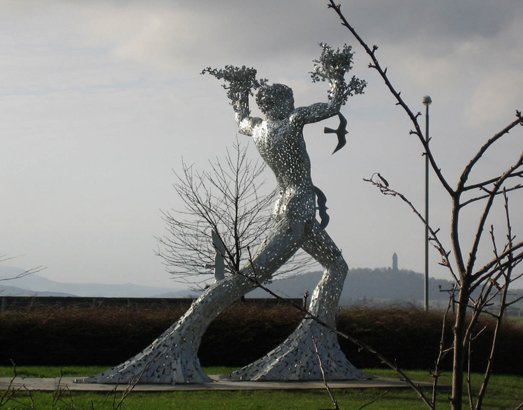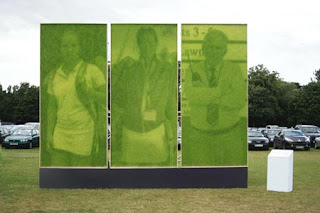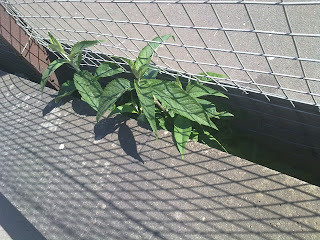The progression of my research into harmony and destruction of the cycle of nature.
Search My Blog...
Thursday, 4 August 2011
Saturday, 7 May 2011
Andy Scott's Metal Process
When thinking about how the metal tree structure could be constructed i thought back to Andy Scott's metalwork sculptures. He constructs his forms not out of solid metal or pure metal sheet but small bits of metal welded together. This means that it is easier to work with and shape which would come in handy as a tree is quite a complex form. Although his structures also have holes in them as part of the style but that could be a practical solution to aid the ivy growing up the tree.
The Tree
On reflection of my research i decided that the "tree of life" was a particularly strong symbol in my ideas. Therefore i have decided that the structure that will be supporting the growth of the ivy should be a bare tree made from metal as it gives the sense of irony and connection between nature and man made materials. As the ivy grows up the tree and covers the metal the tree will look completely natural although as the ivy is on its way up the tree or dying in winter the metal structure will be revealed and shown that infact it is man that has held up this "natural structure".
Golden Hop Vine.
In my research of the many many ivies i found the Golden Hop Vine. It seems like a perfect type of ivy to use in my piece. It has a bright yellow-green leaf and seems to be very low maintenance. It can survive in low temperatures, which would be a necessity if it were to be placed in Kelvingrove park, but also it does not cope well with extreme heats which is not a problem for Scotland anyway.
Although what interested me most about this ivy is that it dies down to the roots every winter. This would mean it would grow every summer and die every winter meaning that the structure it was to grow on would not be permanently covered but would be revealed and covered over time. This would mean that it would be in a cycle: as the ivy grows the man made structure would support it in its growth, but also in doing so the ivy is covering the structure and taking it over. Although...come winter, the ivy dies and the ivy needs the structures support an the cycle starts again. I feel this method certainly reflects the relationship that we have with nature and gives the sense of connection we both should and do have with it.
Although what interested me most about this ivy is that it dies down to the roots every winter. This would mean it would grow every summer and die every winter meaning that the structure it was to grow on would not be permanently covered but would be revealed and covered over time. This would mean that it would be in a cycle: as the ivy grows the man made structure would support it in its growth, but also in doing so the ivy is covering the structure and taking it over. Although...come winter, the ivy dies and the ivy needs the structures support an the cycle starts again. I feel this method certainly reflects the relationship that we have with nature and gives the sense of connection we both should and do have with it.
Active Material?
Inspired by the way ivy works I've decided to use ivy almost as an "active" material in my piece. Instead of having plants or trees put in my piece as they are i thought maybe the act of the ivy growing and spreading could play a big part in it. This reflects of the way Jason deCaires Taylor's underwater pieces shift and change in the environment and almost become one with it. So i have decided to look more into different ivies and see just how they grow and change etc.
Friday, 6 May 2011
Location Location Location
Talking with Gaylie Runciman I was told that Glasgow has the most parks and grassland areas in any city in Scotland so i was thinking that what better place to have my sculpture than in Kelvingrove Park. We are surrounded by nature all the time, especially in glasgow and i think this would be a perfect place for it.
Creepers
When taking pictures over Glasgow I often found buildings that have been taken over by ivies. So i did a little research into ivies and foudnt hat they are much more interesting than i had thought. Boston ivy (or Japanese Creeper) which is a common ivy is often thought of as a pain because of its spreading nature. Like many ivies it rapidly "creeps" onto objects engulfing it, holding on with adhesive pads that occur from secreting calcium carbonate. As it does this it can cause damage to the whatever it is attatched to when one tries to detach it. This gives them a nature almost like a disease or mould. Although when these ivies grow large and are well kept they can be very attractive and pleasant to look at, often complimenting a building and almost connecting it to nature.
Chernobyl
The story of Chernobyl is an incredible example of how nature thrives. After a population of 50,000 people prior to the nuclear accident all that survives in the city is few animals, trees and plants. The city has grown into a forest, as nature has taken over and invades human creation and reclaims it back to the Earth. These pictures tell the story of the disaster and its now lost wreckage.
These Whikeers fish are among the few animals to survive after being exposed to the contaminated, radiated waters surrounding Chernobyl.
These Whikeers fish are among the few animals to survive after being exposed to the contaminated, radiated waters surrounding Chernobyl.
Wednesday, 4 May 2011
Patrick Blanc
I found a botanist called Patrick Blanc who creates these stunning "Vertical Gardens". These are along the same lines as Ackroyd and Harvey's seedling grass works but are just great examples of how versitile nature can be. It looks almost impossible and somewhat like the buildings are being infected or taken over by the mass of green.
ScribblerToo
 I "stumbled" upon a great online drawing tool called "ScribblerToo". It's an adaption of the first Scribbler drawing tool and it consists of a really easy interface that lets you draw interesting sketches with the variables in the brush settings. The reason i particularly like this is whilst experimenting with the brush settings i realised that some of the effects you can get are very natural looking and almost resemble roots or moss. So i have been using this tool to sketch out some ideas etc and I'll see what comes out.
I "stumbled" upon a great online drawing tool called "ScribblerToo". It's an adaption of the first Scribbler drawing tool and it consists of a really easy interface that lets you draw interesting sketches with the variables in the brush settings. The reason i particularly like this is whilst experimenting with the brush settings i realised that some of the effects you can get are very natural looking and almost resemble roots or moss. So i have been using this tool to sketch out some ideas etc and I'll see what comes out. Scribbler Sketches
I used the "ScribblerToo" online drawing tool to make these images. I used the brush settings to get a natural looking effect of curved flowing vines almost and applied it to very structural unnatural looking forms.
Tuesday, 3 May 2011
Beneath the Sea
I have come across these sculptures numerous times and i think they're amazing. Jason De Caires Taylor created an underwater sculpture park in Grenada West Indies. This goes to show that the location of an artwork realy is very important, as being underwater gives these sculptures a whole knew dimension. The landscape of the sea floor constantly shifts as parts of the sculptures are revealed and hidden always changing them. I particularly love the way that these forms (being forms of people) become home to many living things and become inhabited giving the sense of the closest connection we could have to nature and other living beings. It also shows how nature will take back anything that man makes...
Kate MacDowell
Kate MacDowell creates these amazing surreal sculptures out of porcelain. They encorporate the ideas of humans and nature and combines them in clever mutated forms.
Ackroyd and Harvey
Ackroyd and Harvey are visual artist who have collaborated since 1990. Ecology, architecture, sculpture, and photography are some of the disciplines that intersect in Ackroyd & Harvey’s work with their use of grass seeds on architecture for example. Their work highlights the nature of processes of growth and decay in sites of architectural and ecological interest as well as art galleries and museums. Their work almost portrays a connection with nature and the subject that they combine it with, whether it be a picture of people made out of seedling grass or a building covered in it.
Monday, 2 May 2011
Cordyceps
In the talk from Paul Stamets about mushrooms saving the planet he talks about fungi that infects a host such as an ant and uses its body as a growing ground so it can spore. I found this video of Planet Earth with David Attenbourgh about the Cordyceps fungi that do this and found it really interesting staying along the lines of the way nature overcomes anything really.
Largest Organism in the World.
I came across in my research the giant Armillaria Ostoyae fungus. Most people believe that the blue whale is the largest organism on earth but infact it is the Armillaria as it covers 2,384 acres of land in eastern Oregon. Although the most interesting part about the Armillaria for me is the fact that on the surface it looks like any ordinary mushroom but it is underneath the ground that the giant fungus's network spreads and feeds off the roots of trees excreting a digestive enzyme. It is a good example of how powerfull nature can be without us knowing it as we only found it in 1998. I like the sense of it growing and thriving and taking over the underground roots and become a part of it. Here, Paul Stamets gives a talk on how this mushroom and others can save the world through pesticides, treating smallpox and cleaning poluted soil etc.
Gif. Imaging
When using the Flame Painter i created the images of flowers but i found out how to create "gif." animation images and created this image. I feel this has a reflection on the way that David Nash makes sculptures that are both natural but look unnatural. It almost looks as though the flowers are being poisoned or taken over.

Stumbling
Stumbleupon is a great tool that provides an internet toolbar that takes your selected preferences and hobbies and provides you with a random "liked" site evertime you click "stumble". It is a really usefull tool that i find really usefull for my reasearching and development for my project. I simply use the search bar to type in what i want the search to narrow in on and it gives me interesting sites that i have found really useful so far.
Thursday, 28 April 2011
All Around Us
When taking pictures around Glasgow i realised just how much trees and plants there are in amongst the city. It is quite staggering compared to my origional assumptions. Whether it be trees growing alongside houses or a single weed sprouting in between slabs, nature still thrives within the city. Its almost as though there is no stopping it.
Wednesday, 27 April 2011
Picture time
After being inspired by David Nash's works I previously posted I am just about to go out and search for areas or things around Glasgow that show the connection and harmony but also the contrast between the city and nature. Although as I'm typing I've just stupidly realised that right outside my flat window there is a small park that is bang in the centre of the city and is actually completely out of place even though it has never come across to me like that. It's interesting how when I take a step back sometimes I realise that we are not so disconnected from nature as much as i had originally thought.
Pyramid, Sphere, Cube
Another work by David Nash that particularly interested me was his very literal "Pyramid, Sphere, Cube" (1997) sculpture. It consists of a pyramid, sphere and made out of Oak that has been charred on the outside to make it black. To me I find it particularly fascinating is the way that Nash takes wood which is completely natural and almost the essence of what one thinks of as nature and transforms it into something that when looked at against the backdrop of grass and plants looks completely out of place and unnatural. I really like this sense of at once being nature and contradicting nature.
The Green Man
The tradition of The Green Man, portraying a human face amongst or a part of leaves or vegitation is very old in Northern Europe. It seems to be linked to when the Romans invaded the Celtic and Germanic lands as the native art was know for complicated twisting and knotting forms of vegitation. They are often found by church doors or on chancel screens or very hidden in corner carvings so that they are a surprise when seen. The tradition of the green man was that of a giant who lived in the woods, wearing nothing but a suit of leaves with shaggy hair and a beard. He was often associated with the change and transformation symbolised by the vegetation and allusions to the seasonal cycles of nature. There is even a Green Man Festival.
Giuseppe Arcimboldo
Giuseppe Arcimboldo was an Italian artist who painted surreal portraits of his sitters compiled as fruit, fish, books, flowers and vegetables.
Tuesday, 26 April 2011
David Nash's Wooden Boulder
I was recently told about a work by sculptor David Nash simply called "wooden boulder". It is a 25 year work that featured in a documentary by Welsh film maker Pete Telfer. It started when Nash was called out to cut down a tree for safety reasons and he had planned on using the boulder he had cut from it in his studio, but instead pushed it into a nearby river where is sat the bottom of a waterfall and he thought it looked like it was in the right place. It then intermittently moved downstream whenever the river swelled and overtime has moved kilometers and is now in the sea although Nash likes to think that it is not lost but rather "it is where it is." He likes the notion that wood that grew out of the ground will finally return to it which i feel sums up the sense of harmony and cycle of nature well.
Sunday, 17 April 2011
"Stride"
Who would've thought it? Around about 400 meters from my house is the perfect example of the combination of people and nature. It is a sculpture called "Stride" by Andy Scott a Glaswegian who has done many public artworks over the UK and many of them have luckily been in Alloa where i live.
I think this is a good representation of the connection between humans and nature and how we should be at one with nature and embrace it not destroy and control it.
Although unfortunately it was recently a victim of a hit and run from a motorist... and sadly it is temporarily no more...looks pretty relaxed to me.
 |
Although unfortunately it was recently a victim of a hit and run from a motorist... and sadly it is temporarily no more...looks pretty relaxed to me.
 |
| http://outdoors.caledonianmercury.com/2011/02/16/when-art-meets-acceleration-andy-scott-sculpture-smashed-by-boy-racer/001552 |
Double Exposure: At One With Nature
I found these pretty amazing double exposure photographs by Dan Mountford on Fubiz. (they can be seen here: http://www.fubiz.net/2011/04/01/double-exposure-portraits/ .
This series of double exposure photographs particularly interested me in the way he uses the technique to combine portraits of people with images of architecture and nature especialy. So i took this idea of imaging people combined with nature as it portrays this idea of "at one with nature" and almost "a part of nature" and made my own images using a similar technique on photoshop.
Subscribe to:
Comments (Atom)

















































